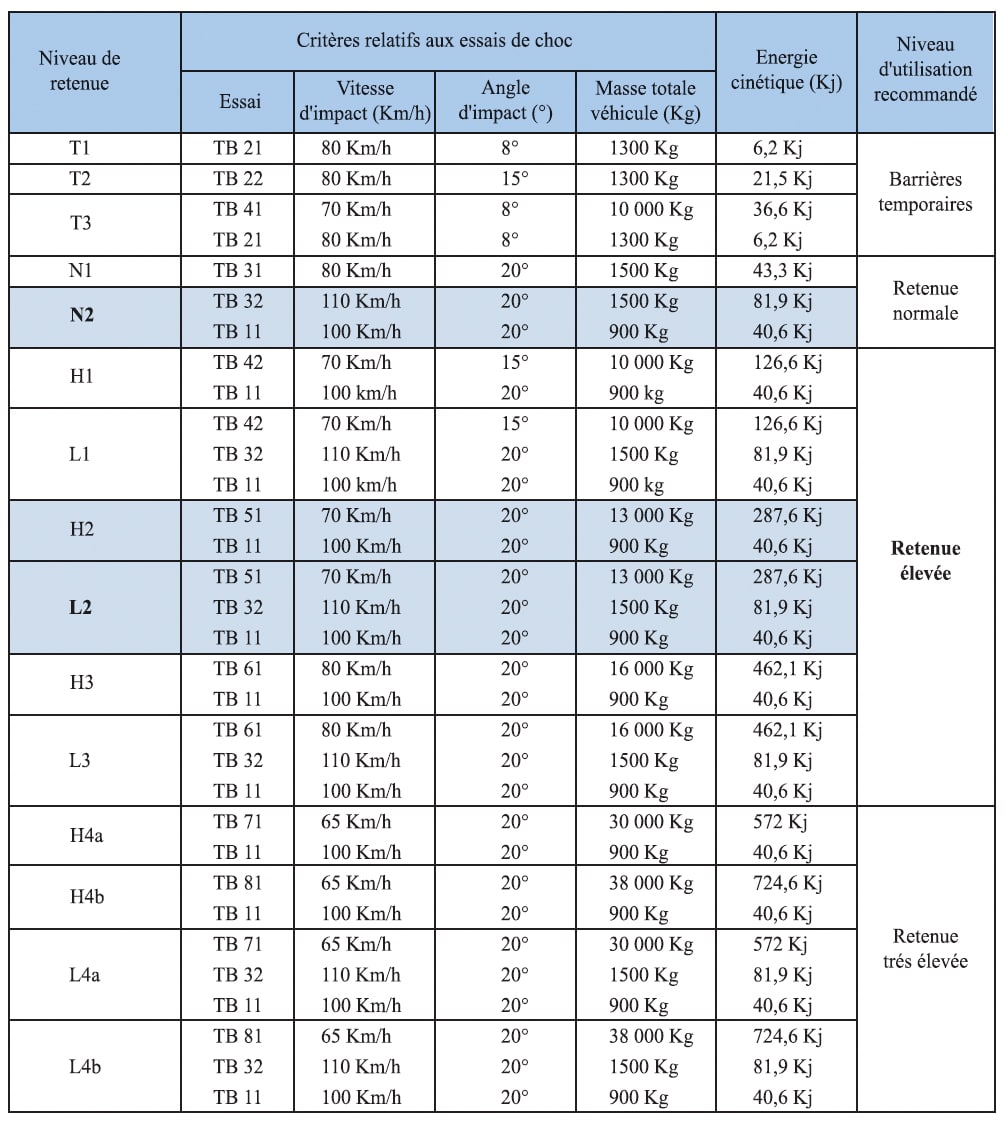SAFETY BARRIERS
The performance of the safety barriers is evaluated according to 3 criteria :
- Containment level
-
Acceleration Severity Index (ASI – Acceleration Severity Index)
- The distortion expressed by :
– the working width (W – Working Width)
– the dynamic deflection (D – Dynamic Deflexion)
– the intrusion of the vehicle (Vi – Vehicle Intrusion).
To measure the performance of a safety barrier, full-scale impact tests are performed.
CONTAINMENT LEVEL
The EN 1317 standard defines the containment levels and the criteria of the crash tests as indicated below :
 |
It is the responsibility of the road owner to select the containment level of the safety barriers according to the traffic and installation conditions in accordance with the regulations in force. |
IMPACT SEVERITY CLASS
The assessment of the severity of the impact for the passengers of the vehicle is evaluated according to the following indicators:
- ASI =Acceleration Severity Index
- THIV = Theoretical Head Impact Velocity
The ASI of a restraint system is established on a scale of 3 levels: from the least violent (A) to the most violent (C). These criteria are measured during TB11 crash test common for all containment levels except N1.

| Level | Test results ASI |
Test results THIV |
| A | ≤ 1,0 | |
| B | ≤ 1,4 | ≤ 33km/h |
| C | ≤ 1,9 |
LA DEFORMATION : LARGEUR DE FONCTIONNEMENT
The working width (W) is the maximum lateral distance between any part on the undeformed traffic side and the maximum dynamic position of any part of the barrier. It is expressed in meters (m).
 |
The working width must be considered when installing a RRS in front of a lateral obstacle close to the road (trees, posts, etc.) |
The working width of a device is evaluated according to the values below :

DEFORMATION: THE DYNAMIC DEFLECTION
Dynamic deflection (D) is the maximum lateral dynamic displacement of any point of the traffic face of the restraint system, expressed in meters.
 |
The dynamic deflection level must be taken into account when installing a safety barrier near a drop.
|
DEFORMATION: INTRUSION OF THE VEHICLE
The vehicle intrusion VIm of the Heavy Goods Vehicle (HGV) only concerns high containment level H barriers.
It measures the distance between the side of the barrier exposed to traffic before the impact and the maximum dynamic position of the vehicle.
 |
The intrusion of the vehicle is particularly important to take into account when installing barriers in front of fixed obstacles. It is also relevant for the installation of barriers on bridge parapets. |

Crash-test steel barriers H4BP (inside view) : Watch the video
TRANSITIONS
Transitions devices connect two safety barriers having different performances & lateral stiffnesses. Currently, they cannot be CE marked as it doesn’t exist so far, a harmonized standard concerning them. For the time being transition issue is covered by pre-standard ENV 1317-4 only.
However :
- In France, transitions must be certified NF 058, in accordance with the RNER (National Regulation of Road Equipment), or alternately shall have a certificate of conformity marking offering an equivalent level of safety
- In Germany the regulations require crash tests according to the experimental standard ENV 1317-4
- In other member states or countries affiliated to the European Union, there is no particular requirement regarding the transitions.
Marcegaglia H3 to H2 transition simulation example : Watch the vidéo



